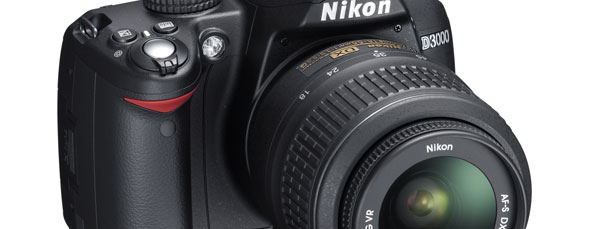Nikon D3000

10.2-MEGAPIXEL ENTRY-LEVEL DSLR CAMERA
Nikon’s 10.2-megapixel D3000 is their latest entry-level DSLR. It’s aimed at consumers stepping up from a point-and-shoot who want a camera that’s easy to learn but not lacking in sophisticated features.
The D3000 borrows from higher-end Nikons, such as the D90, and it includes 3D tracking, active D-lighting, and Nikon’s EXPEED image processor. Unlike the D90, which uses a faster CMOS sensor, the D3000 uses the slower DX-format, APS-C CCD sensor found in its predecessor, the D60. The D3000 improves on the D60 by upgrading from a 3- to an 11-point AF system, installing a 3″, 230,000-dot LCD, and using a new guide mode to simplify orientation to the camera. Nikon takes a gamble by not including a movie mode or Live View features that lure beginners.
The hard, plastic body is comfortable and well balanced, with a textured grip located within easy reach of the shutter release button and command and thumb dial. The command dial modes include: manual, auto, program, aperture, and shutter priority; six scene presets; and the new guide, which is a good starting place for beginners before moving on to master more advanced modes. The guide directs you in setting up the camera and setting options for shooting, viewing, and deleting your images. It also shows you how to achieve easy and advanced photographic effects, such as freezing action or maximum depth of field, then it automatically sets itself to achieve the effect—very well implemented.
As there’s no Live View, the LCD is strictly for playback, viewing shooting information, and menus. All image composing is done with the optical viewfinder, which covers 95% of the field and clearly displays pertinent shooting information. On top, the D3000 has a hot shoe and a built-in flash. The camera supports RAW and JPEG file formats and it has a single SD memory card slot.
Performance is varied. The D3000’s 11-point autofocus system is fast in daylight and in low light. The three metering systems—matrix, center-weighted, and spot—work well. The camera’s ISO range is 100–1600 with an expanded high ISO of 3200 for low-light situations. Image quality is very good up to ISO 800 and the camera produces beautiful tabloid-size prints. The active D-Lighting feature makes an impressive difference to preserve detail in the highlights and shadows and the auto white balance is right on the money. The D3000’s image stabilization is lens-based and it ships with a decent Nikkor 18–55mm, f/3.5–5.6 VR kit lens that buys you an extra 2–3 stops of steady shooting. When you rotate the D3000 for composing in portrait orientation, the information on the LCD is synchronized to rotate as well—an especially nice touch.
This camera is slow, taking almost five seconds after pressing the shutter release button to see the image on the LCD. It shoots continuously at a modest 3 frames per second and, despite using a high-speed SD memory card, the D3000 was very sluggish when clearing the buffer and readying itself for more shooting. It’s not built for fast, continuous action photography.
On most DSLRs, the four-way navigation button serves a dual purpose for scrolling through the menus and is labeled and used for quick, direct access to features such as ISO, metering, AF, etc. On the D3000, however, it’s strictly for menu navigation, and a button marked “i” accesses an onscreen panel of frequently used features and their options. Ultimately this approach slows things down. Happily, the menus are straightforward. The bottom line is that for less than $600, the D3000 is a good deal.—Steve Baczewski
Company: Nikon Inc.
Price: $549.95 (Body only); $599.95 (w/18–55mm VR kit lens)
Web: www.nikonusa.com
Rating: 4
Hot: Easy-to-use DSLR for those stepping up from a point-and-shoot
Not: Doesn’t feature a built-in AF motor to drive older lenses
